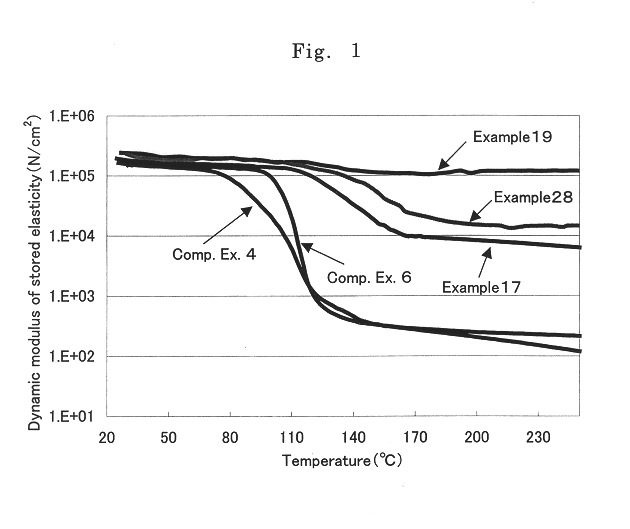Curing agent for epoxy resin, epoxy resin composition and method for preparing siloxane-modified phenol resin
a technology of epoxy resin and curing agent, which is applied in the field of curing agent for epoxy resin, can solve the problems of insufficient heat resistance of epoxy resin compositions containing phenol novolac resins as curing agents, insufficient mechanical properties of cured epoxy resin compositions, and insufficient heat resistance of resin compositions using fillers, etc., and achieves high heat resistance
- Summary
- Abstract
- Description
- Claims
- Application Information
AI Technical Summary
Benefits of technology
Problems solved by technology
Method used
Image
Examples
example 1
Into a reactor equipped with a stirrer, water distributor, thermometer and nitrogen gas introduction tube were placed 859.5 g of novolac phenol resin ("Tamanol 759" produced by Arakawa Chemical Industries, LTD., trade name) and 400 g of dimethylformamide. The novolac phenol resin and dimethylformamide were dissolved at 100.degree. C. Into the reactor were further placed 190.5 g of the partial condensate of tetramethoxysilane ("Methyl silicate 51" produced by Tama Chemicals Co., Ltd., trade name, average number of Si per molecule: 4) and 2 g of dibutyltin dilaurate as a catalyst. The mixture was heated at 110.degree. C. for 6 hours to subject to dealcoholization reaction, and then cooled to 80.degree. C. The mixture was diluted with dimethylformamide, giving a solution of a siloxane-modified phenol resin (phenolic hydroxyl equivalent of 338, curing agent A) having a nonvolatile content of 50%.
In the starting materials, (phenolic hydroxyl equivalent of phenol resin (1) / alkoxy equivale...
example 2
Into the same reactor as used in Example 1 were placed 662.5 g of a novolac phenol resin ("Tamanol 759" produced by Arakawa Chemical Industries, LTD., trade name) and 400 g of dimethylformamide. The mixture was dissolved at 100.degree. C. To the mixture were further added 587.5 g of a partial condensate of tetramethoxysilane ("Methyl Silicate 51" produced by Tama Chemicals Co., Ltd., trade name) and 2.8 g of acetic acid as a catalyst. The mixture was heated at 110.degree. C. for 6 hours to subject to dealcoholization reaction. The mixture was cooled to 80.degree. C. and diluted with dimethylformamide, giving the solution of a siloxane modified phenol resin (phenolic hydroxyl equivalent of the solution: 614, Curing agent B) having a nonvolatile content of 50%.
In the starting materials, the equivalent ratio of (phenolic hydroxyl groups of the phenol resin (1) / alkoxy groups of the hydrolyzable alkoxysilane (2)) was 0.5. The amount of removed methanol by the dealcoholization reaction wa...
examples 3-15
The solutions of siloxane-modified phenol resins shown in Table 1 were prepared (Curing agents C-O) following the procedure of Example 1 except that at least one of the conditions under which Example 1 was carried out was changed. The conditions are the types and amount of the novolac phenol resin (1), reaction solvent, hydrolyzable alkoxysilane (2), catalyst and diluting solvent; and dealcoholization reaction time.
In Example 8, however, to the resin solution obtained under the reaction conditions shown in Table 1 was further added 28.9 g of water and 1.0 g of triethylamine. The mixture was subjected to partial condensation reaction at 60.degree. C. for 2 hours, giving the solution of a siloxane-modified phenol resin (Curing agent H).
In the above Table 1, trade names and abbreviations represent the followings: (1) "Tamanol 759": novolac phenol resin produced by Arakawa Chemical Industries, LTD., trade name (2) "Tamanol 756D": Cresol novolac phenol resin produced by Arakawa Chemical ...
PUM
| Property | Measurement | Unit |
|---|---|---|
| Fraction | aaaaa | aaaaa |
| Fraction | aaaaa | aaaaa |
| Fraction | aaaaa | aaaaa |
Abstract
Description
Claims
Application Information
 Login to View More
Login to View More - R&D
- Intellectual Property
- Life Sciences
- Materials
- Tech Scout
- Unparalleled Data Quality
- Higher Quality Content
- 60% Fewer Hallucinations
Browse by: Latest US Patents, China's latest patents, Technical Efficacy Thesaurus, Application Domain, Technology Topic, Popular Technical Reports.
© 2025 PatSnap. All rights reserved.Legal|Privacy policy|Modern Slavery Act Transparency Statement|Sitemap|About US| Contact US: help@patsnap.com

